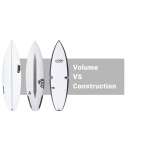Are you surfing the wrong board?
How Surfboard Volume changed the industry
These days it's uncommon for surfboard shapers to disregard volume completely. "How many liters is that?", a common phrase thrown around between mates and professional surfer / shaper relationships. Surfers using Volume Metrics and
Surfboard Volume Calculators have become the norm to really dial in their equipment.
Since Computer Assisted Design (CAD) Programs are being used by an increasing amount of surfboard shapers, it's widely recognized that Volume is one of the most crucial elements when dialing in the perfect board for a surfer’s age, height, weight, ability and the type of waves they will be surfing.
Elite level surfers like Griffin Colapinto, John John Florence and Steph Gilmore can feel the difference in as little as 0.5 Liter change in their equipment. At this level of surfing, even half a liter can really impact surfing performance, especially on
step up boards.
A beginner may not even understand or take into consideration the volume of a surfboard, but when they are struggling just to paddle into waves while their friends are riding all the way to the beach, they will quickly find out how important the right equipment can be.
The wrong equipment can make or break someone's decision to stick with surfing, and shows how important it is even for beginners to get the right
beginner surfboard size.
So, how do you determine the right volume for you?
Knowing Your Surfboard Volume
There are many factors that come into play when determining the right volume for your surfboards. Age, ability, frequency and the type of waves you generally surf all play important roles in finding the right
surfboard volume.
The full dimensions of a board are great to know, but it’s the distribution of the foam throughout the outline that will impact the volume and the performance of your surfboard.
Knowing your volume will help to determine the right equipment for you no matter the level of surfing you are at. Fortunately these days there are many surfboard volume calculators and volume charts that have been developed to help you determine what volume is best for you. Lots of these volume calculators however, can be pretty general and only really take your weight into consideration.
What happens if there are other factors involved?
Advanced calculators like the
Board Engine, can take your age, fitness level, surfing ability, type of waves and style of board you prefer all into consideration. Give it a try:
When you think about it, it’s pretty obvious. If you have two people, both 180cm and 75kg, but one of them is 25 and the other is 60, they probably shouldn’t be surfing the same board. Any surfboard volume calculator should then take this information into consideration.
 Jack Freestone needs to make sure his new Pyzel Surfboards quiver is finely tuned for competition.
Jack Freestone needs to make sure his new Pyzel Surfboards quiver is finely tuned for competition.
Finding the Volume of a Surfboard and the Use of CAD programs
In past years, volume was considered, but rarely ever measured. You used to just feel the rails and throw the board under your arm to get an idea of how she was going to float.
Lots of people still swear by the old board under the arm test, and for the most part, it’s still a good way to feel out a board. If you have some surfing experience, you will always be able to use this method and know to some degree how that board will perform for you.
The use of CAD programs have allowed shapers to easily find and refine a surfboard’s volume without going through the painstaking and sometimes inaccurate method of using a displacement tank to do so. This makes it easier to dial in one's equipment for optimal performance. As noted above, an advanced surfer can feel the difference in as little as .5L change in volume.
So, now that we can calculate and refine the volume of a surfboard with relative ease, we have to consider how the volume relates to the surface area, outline and distribution of foam through a board.
 Colin Moran and his Panda Surfboards Dolly Dagger.
Colin Moran and his Panda Surfboards Dolly Dagger.
Volume and Shape of a Board
Just because your surfboard looks bigger, doesn’t necessarily mean it floats better. A 6’2 standard shortboard could very well have less volume than a 5’4 groveler.
Take two boards with similar dimensions.
Let’s say both are 5'9 x 19"1/2 wide (at widest point) and 2"3/8 thick (at thickest point). Board number 1 is a pin tail, while board number 2 has a wider tail. Likewise, board number 1 has a refined, pulled-in nose, while board number 2’s nose is rounder. You’re going to find that board number 2 is likely to have significantly more volume than board number 1 because of its shape.
 Board Comparison: Sharp Eye Surfboards #77 on the left and Disco Cheater on the right.
Board Comparison: Sharp Eye Surfboards #77 on the left and Disco Cheater on the right.
This doesn’t necessarily mean that one board is better for you than the other.
Board number 1 is likely to be a performance shortboard - similar models include the
Sharp Eye 77,
Album Reboot, or the
Chilli Faded - and it's going to perform best in waves with a bit of push behind them or when you're looking for some extra hold in barreling conditions.
Board number 2 is most likely more of a grovel board - similar to the
Pyzel Gremlin,
SUPERbrand Fling, or the
Haydenshapes Holy Grail - and will be a blast on a softer waves with less push.
Figuring out the right volume for you will be a combination of the dimensions of the board, and the volume combined with the surface area of the board, all in relation to your age, ability, fitness level and the types of waves you generally surf.
You can’t just stick with one volume and have all your boards shaped around it. In good quality waves, too much volume will mean you sacrifice performance. Yes, you will be able to paddle into the wave with ease, but it will be difficult to set your rail and transition from rail to rail.
In larger waves over head high and bigger, you may find you'll get the best performance from something like a
DHD Ducks Nuts or a
Surf Prescriptions G-Money II.
Likewise, in softer, less powerful waves, if your board has too little volume you may be sacrificing wave count. You may even find that your board bogs or sinks into the wave.
In these kind of waves you’ll find a mush machine like the
Sharp Eye Sole or the
Vampirate Inflatable Mattress could be your best option.
Construction and Materials
 Boards listed from left to right: DHD DNA in PU, Lost Uber Driver in Carbon Wrap, Haydenshapes White Noiz in FutureFlex.
Boards listed from left to right: DHD DNA in PU, Lost Uber Driver in Carbon Wrap, Haydenshapes White Noiz in FutureFlex.
There is a lot of speculation that the construction of a surfboard changes the volume. People claim the EPS and
Epoxy Surfboards 'float' more on the water and you feel more on top of the wave compared to a standard Polyurethane and Polyester (PU) board.
While the verdict still seems to be out on the subject, both styles of boards remain popular for different reasons. Epoxy boards are definitely lighter compared to poly (PU) boards, but does that actually mean they float more? If you want to learn more, check out our in-depth comparison between
PU or Epoxy - Which is best?
Do you think the CAD program or the displacement tank really knows the difference between the two constructions?
The thing to remember is, while the volumes are going to be the same (or damn close) for 2 of the same models in the same dimensions, 1 in PU and 1 in Epoxy, the performance will be different. Remember, this has nothing to do with the volume of your board, but rather, the weight of the board.
You’ll find that paddling around the line-up and the ability to paddle into waves will be very similar if not the same between the two constructions. However, using the weight of a poly board can help you get down the line while the lightness of the epoxy board is great for whipping it around through turns and airs. This is where the performance difference lies.
Also, when the conditions are not so great, you may find the extra weight of the PU board will help plow through choppy water instead of bouncing or chattering on the surface of the wave like an epoxy can.
The Verdict
Don’t waste your time surfing all the wrong equipment!
Using an advanced volume calculator like our
Board Engine will take into consideration many of the variables needed to determine what type of equipment you should be looking for, helping to set you in the right direction.
The tools are out there to dial in your ideal board or boards - everyone should have a quiver!
Combine this with some common sense, experience, as well as your shaper's knowledge and you'll be well on your way to building the quiver of your dreams.
Just as the right volume ensures optimal buoyancy and paddle power, the right shape determines how your board interacts with the waves. Moreover, the choice of fins is equally crucial. Whether it's the classic control of
twin fins, the versatility of
thruster fins, the speed of
quad fins, or the adaptability of
five fins, your fin setup can significantly impact your performance. By grasping the interplay between volume, shape, and fin configuration, you'll be well-equipped to make the most of your surfing journey. So, whether you're riding the classic twin fins or experimenting with cutting-edge quad fin setups, remember that each aspect plays its part in shaping your experience on the waves.










